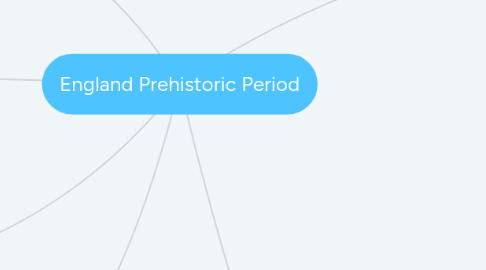
1. Stone Age Periods
1.1. Palaeolithic periods
1.1.1. 800.000 years ago britain was join to contenial Europe by the wide land briges allowing people to move freely. Animal bones and flint tools was found in East Anglia. The early people made a flint tool called handaxes and hunted large.
1.1.2. The extreme cold ice of the ice ages in Britain probably humans forced to live because of the impossible condition, but it returned to warmer periods. The final ice ages of Britain around 70,000 to 12,000 BC. Neanderthals humans living in Britain around 60,000 BC
1.1.2.1. Neanderthals were a separate species from modern humans, and became extinct
1.1.3. The modern humans that lives in Britain use flint tool and bones, antler, shell, amber, animal, teeth and mammoth ivory for tools and jewellery. There's possible that traveller meet and exchange goods, the main food species is wild horse and red deer
1.2. Mesolithic periods
1.2.1. provided fish and wild birds. These food sources required different hunting tools which tiny microliths were developed for fixing onto harpoons and spears
1.2.2. Mesolithic people follow complex pattern of seasonal occupation, or in some cases permanent occupation Tools such as flint scrapers for cleaning animal skins and worked bone and antler have been found, including 91 barbed points. Farming was introduced to Britain around 4,500 BC, Hunter-gather ways of life continued but the increasing range of material culture, such as pottery, leaf-shaped arrowheads and polished stone axes, and the control of local resources by individual groups would have caused it to be replaced by distinct territories occupied by different groups. Farming began in the Middle East, China, India and South East Asia about 10,000 years ago
1.3. Neolithic periods
1.3.1. As farming gradually spread, settled communities dependent on agriculture supplanted the hunter-gatherer lifestyle in many, but not all areas, and introduced new lifestyles referred to as Neolithic
1.3.2. The Middle Neolithic (c. 3300 - 2900 BC) saw the development of cursus monuments close to earlier barrows, the building of impressive chamber tombs such as the Maeshowe types and the growth and abandonment of causewayed enclosures
1.3.3. Different pottery types such as Grooved Ware appear during the Late Neolithic (c. 2900 - 2200 BC) whilst new enclosures, called henges were built, along with stone rows.
2. Metal Age Periods
2.1. Copper age periods
2.1.1. It say that copper age in Britain started roughly between the 25th and 22nd Centuries B.C.E. (Before common era) so the copper age happened before the Bronze age and Iron age. the periods between the late Neolithic and the Early bronze age people started to experiment metal as the materials tools, it's called the Chalcolithic periods. Copper age was a time of profound social and culture change, many of the societies change to hunter-gather lifestyle. there were two metal that became attractive which are gold and copper, gold was pretty and easy to work with but isn't good for making tools so they use it as a jewelry, while the other is copper, copper is relatively easy to heat and work into various shape, but it's much more stronger than gold once it's cooled. They still use stone but they prefer more into metal for making tools they also use copper to use as a weapons or to defense.
2.2. Bronze Age Periods
2.2.1. Around 2400 BC a new set of beliefs and practices, Initially items were made from copper, then from around 2200 BC bronze (which is harder than copper) Early Bronze Age people buried their dead beneath earth mounds known as barrows, often with a beaker alongside the body. From about 1500 BC round houses were built in Britain and their use continued. Iron Age. Most round houses were built from local materials: wooden walls and a roof thatched with reeds or straw In larger houses, the roof space may have been floored over to be used as a loft. Most round houses had a fireplace at the centre for cooking, warmth and light. There were no windows and the doorway often pointed towards the east or southeast to let in the morning sun. The appearance of swords and other weaponry (many of them deposited in rivers and other watery places) suggests a rise in conflict and war
2.3. Iron Age Periods
2.3.1. Around 800 BC iron working techniques reached Britain from mainland Europe. While bronze was still used for objects such as jewellery, iron was used for tools. Britain aspects of Iron Age ways of living may have carried on for a long time after the Roman conquest. Iron Age Britain was essentially rural. Most people lived in small villages and farmsteads with communities run by an individual or small group. Iron axes and iron tipped ploughs made farming more efficient and agricultural production increased. Religious belief and offerings to gods, spirits and ancestors were an important part of life. People did not build temples and few statues of Iron Age deities are preserved.

